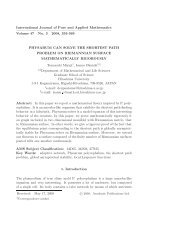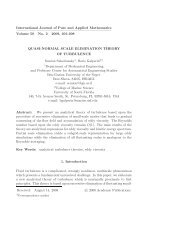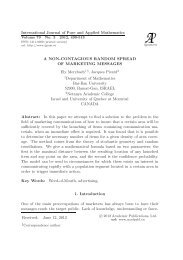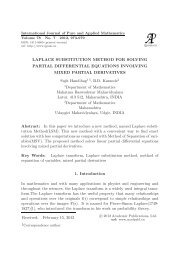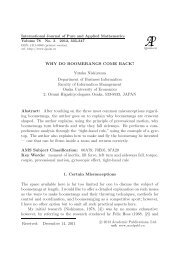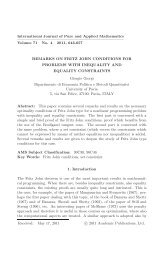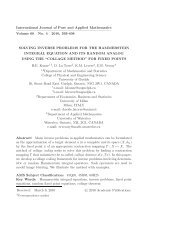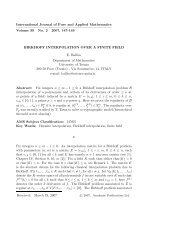CAVITATION, INDENTATION AND PENETRATION
CAVITATION, INDENTATION AND PENETRATION
CAVITATION, INDENTATION AND PENETRATION
You also want an ePaper? Increase the reach of your titles
YUMPU automatically turns print PDFs into web optimized ePapers that Google loves.
<strong>CAVITATION</strong>, <strong>INDENTATION</strong> <strong>AND</strong> <strong>PENETRATION</strong> 363<br />
Figure 1: Conical indentation. Included angle is 2α, imprint radius – a,<br />
hypothetical radial displacement – w. Inner core is bounded by r = a.<br />
Baruch [3], is<br />
Pc =<br />
∞<br />
0<br />
exp( 3<br />
2<br />
Σ (dǫ + βdΣ)<br />
β<br />
ǫ − 2Σ) − 1 + 2βΣ<br />
and for quasi-static, plain strain, cylindrical cavitation of compressible Mises<br />
and Tresca solids we have the general results, Masri and Durban [12], respec-<br />
tively<br />
and<br />
Pc =<br />
∞<br />
0<br />
Σ dǫ + 1−2κ<br />
3 βdΣ<br />
√3ǫ <br />
β<br />
exp − √3Σ − 1 + 2(1−κ)<br />
√ βΣ<br />
3<br />
∞<br />
<br />
Σ dǫ −<br />
<br />
2<br />
1−β<br />
2 dΣ<br />
(6)<br />
with κ = −0.4725, (7)<br />
Pc =<br />
0 exp(2ǫ − 1+β 3−β<br />
2 Σ) − 1 + 2 βΣ.<br />
(8)<br />
Here the total strain ǫ is a known function of the effective Mises stress Σ (nondimensionalized<br />
with respect to E) and β = 1 − 2ν is a compressibility measure.<br />
Formulae (6-8) generalize approximations (1-3) to include strain hardening. In<br />
the absence of elastic compressibility (β = 0) it is possible, Masri and Durban<br />
[13], to derive for power hardening materials the close approximations<br />
Pc = 2<br />
3 Σy<br />
n 2<br />
1 + F(n) −<br />
3Σy<br />
1<br />
<br />
, (9)<br />
n



